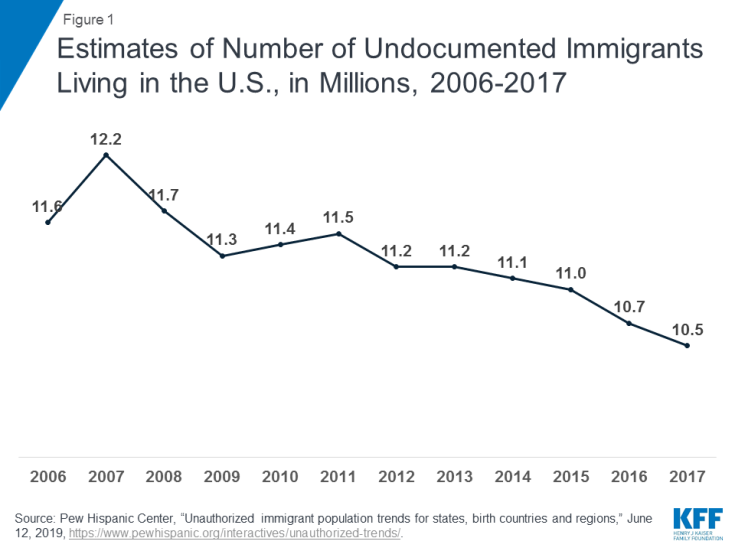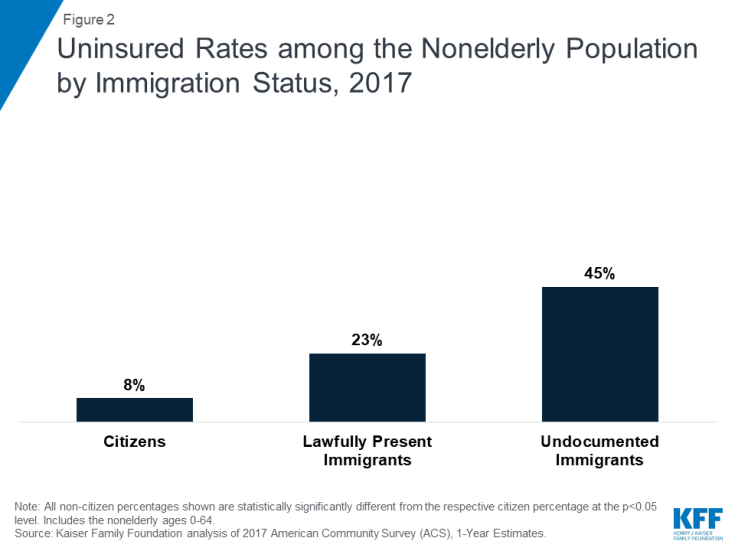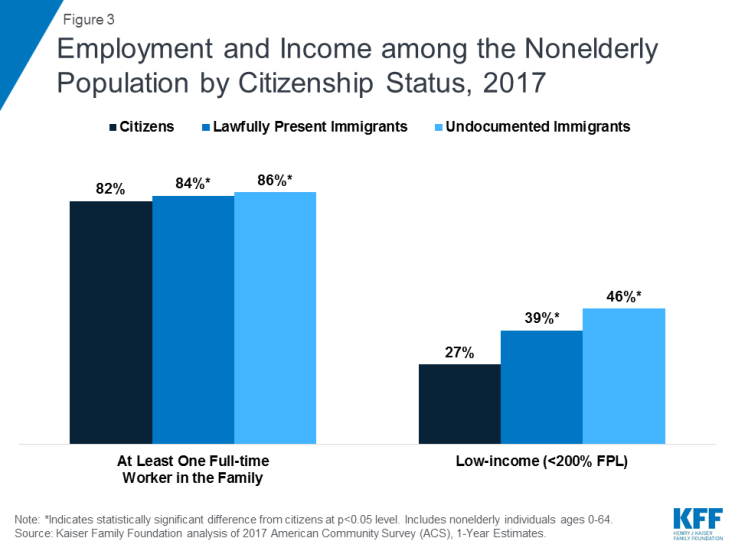Dallas Morni.g News Illegal Immigration Parkland Hospital Babies
| Key Takeaways |
Recently, many of the Democratic presidential candidates indicated back up for expanding wellness coverage to undocumented immigrants. To help inform the implications of such an expansion, this brief provides an overview of current health coverage and care for undocumented immigrants. It shows:
|
Introduction
Recently, many of the Autonomous presidential candidates indicated support for expanding wellness coverage to undocumented immigrants. To help inform the implications of such an expansion, this cursory provides an overview of electric current health coverage and care for undocumented immigrants.
Undocumented immigrants are at high risk of beingness uninsured because they have limited admission to coverage options. They face up barriers to accessing care due to their high uninsured rates.
Overview of Undocumented Immigrants
Undocumented immigrants are foreign-born individuals residing in the U.S. without authorization. This grouping includes individuals who entered the land without authorization and individuals who entered the country lawfully and stayed after their visa or status expired. The master reasons individuals immigrate to the U.S. are for amend job opportunities, to reunite with family unit, and for increased safety.ane Undocumented immigrants account for roughly 4 in ten noncitizens, while the remaining six in ten are lawfully present immigrants. Many immigrant families include people with mixed immigration condition, and the bulk of children with a noncitizen parent are U.S.-born citizens.
It is estimated that at that place were ten.5 meg undocumented immigrants residing in the U.S. equally of 2017, accounting for about 3% of the full U.South. population. 2 Estimates from the Pew Hispanic Middle show that the number of undocumented immigrants in the U.S. has been declining since 2007 (Effigy 1).3 This decline largely reflects a large decrease in the number of new undocumented immigrants. As a result, an increasing share of undocumented immigrants are people who have been living in the U.S. for many years. As of 2017, about two-thirds (66%) of undocumented immigrant adults in the U.S. had been in the U.S. for more than 10 years, upwards from 41% in 2007.four

Effigy 1: Estimates of Number of Undocumented Immigrants Living in the U.S., in Millions, 2006-2017
Health Coverage for Undocumented Immigrants
Undocumented immigrants are at high take a chance of being uninsured. Among the total nonelderly population, 45% of undocumented immigrants were uninsured compared to nearly i in four (23%) lawfully present immigrants and less than i in 10 citizens (eight%) as of 2017 (Figure 2). Although noncitizens are more than likely to be uninsured than citizens, citizens still business relationship for the majority of the nonelderly uninsured, since noncitizens account for a small-scale share of the overall population.

Figure ii: Uninsured Rates among the Nonelderly Population past Immigration Status, 2017
The college uninsured rate among undocumented immigrants reflects limited access to health coverage options.
- Undocumented immigrants are not eligible to enroll in Medicare, Medicaid, or CHIP or to buy coverage through the ACA Marketplaces. Under rules issued past the Centers for Medicare and Medicaid Services, individuals with Deferred Action for Childhood Arrivals (DACA) status are non considered lawfully present and remain ineligible for these coverage options.5 Since 2002, states take had the option to provide prenatal care to women regardless of immigration status by extending CHIP coverage to the unborn child. As of January 2019, 16 states had adopted this option.vi
- Although most nonelderly undocumented immigrants live in a family with a full-time worker (Figure iii), they take limited access to employer-sponsored coverage. They are frequently employed in low-wage jobs and industries that are less probable to offering employer-sponsored coverage. Further, undocumented immigrants are more likely than other groups to be low-income, making it challenging to afford employer-sponsored coverage when it is available.

Figure 3: Employment and Income among the Nonelderly Population by Citizenship Condition, 2017
Electric current coverage among undocumented immigrants reflects a limited array of private coverage and some state- or locally-funded programs. Some undocumented immigrants may get coverage through their employer or as a spouse or dependent of an employee. Undocumented immigrants tin also purchase individual coverage on the individual market outside of the ACA Marketplaces, although many may not be able to afford this coverage due to their limited incomes and lack of subsidies to offset the costs of this coverage. Some undocumented immigrants may as well exist covered through student health programs. Vi states (CA, IL, MA, NY, OR, and WA) and DC use land-simply funds to cover income-eligible children regardless of immigration status.seven In June 2019, California approved an expansion in coverage for income-eligible immature undocumented immigrant adults through historic period 25.
Wellness Intendance for Undocumented Immigrants
Given their higher uninsured rates, many undocumented immigrants delay or become without needed care. Enquiry shows that having insurance makes a divergence in whether and when people admission needed care.eight Those who are uninsured often filibuster or go without needed care, which can lead to worse health outcomes over the long-term that may ultimately be more complex and expensive to treat.9
Undocumented immigrants can obtain depression-cost intendance through community wellness centers. However, care available through clinics is oft express to preventive and main care, leaving them to confront challenges in accessing specialty services.
Under federal law, hospitals are required to screen and stabilize every patient who seeks emergency intendance. Medicaid helps offset costs borne past hospitals in providing emergency care to undocumented immigrants past providing payments to hospitals for emergency care provided to individuals who are otherwise eligible for Medicaid but for their immigration status.
Immigrants spend less on health intendance, compared to their U.South. born counterparts. 10 They also make larger out-of-pocket health care payments compared to nonimmigrants.11 Immigrants have lower spending, in part, because they use less intendance due to their depression coverage rates and limited admission to care. They too tend to be younger and healthier than nonimmigrants, although this difference decreases over time as immigrants spend longer in the United States.12
Current Bug
Enquiry shows that shifting immigration policies nether the Trump administration are leading to substantially increased fears among the immigrant community, affecting undocumented immigrants too every bit lawfully nowadays immigrants and citizen children of immigrants. xiii Growing reports suggest that these fears are causing families to turn away from utilizing programs and services for themselves likewise as their children, who are primarily U.S. born citizens and may qualify for Medicaid and CHIP.14 The administration is pursuing additional changes to public charge policies that may lead to even larger decreases in participation in Medicaid among lawfully nowadays immigrants and citizen children of lawfully present and undocumented immigrants.xv Declines in coverage for families would increment barriers to care and financial instability, negatively affecting the growth and healthy development of their children.
Although the Democratic presidential candidates take indicated back up for expanding coverage to undocumented immigrants, to appointment, there are no detailed proposals. The bear upon and costs of such an expansion would depend on how individuals are covered (east.one thousand., through individual coverage, Medicare, or Medicaid), what benefits are provided, and premium and price-sharing levels. Some of the toll would be outset by existing resource currently going toward care for undocumented immigrants. An expansion would too likely shift the residue of how costs of care for undocumented immigrants are borne across the federal government, country and local authorities, private entities, and individuals. California'south recently approved expansion would cover young adults through the state's Medicaid program using state-only dollars. The land has budgeted $98 1000000 dollars for the expansion in the starting time yr, which is estimated to cover 90,000 people.16 Even if coverage is expanded, fears among immigrant families could limit participation.
Source: https://www.kff.org/racial-equity-and-health-policy/issue-brief/health-coverage-and-care-of-undocumented-immigrants/
Post a Comment for "Dallas Morni.g News Illegal Immigration Parkland Hospital Babies"